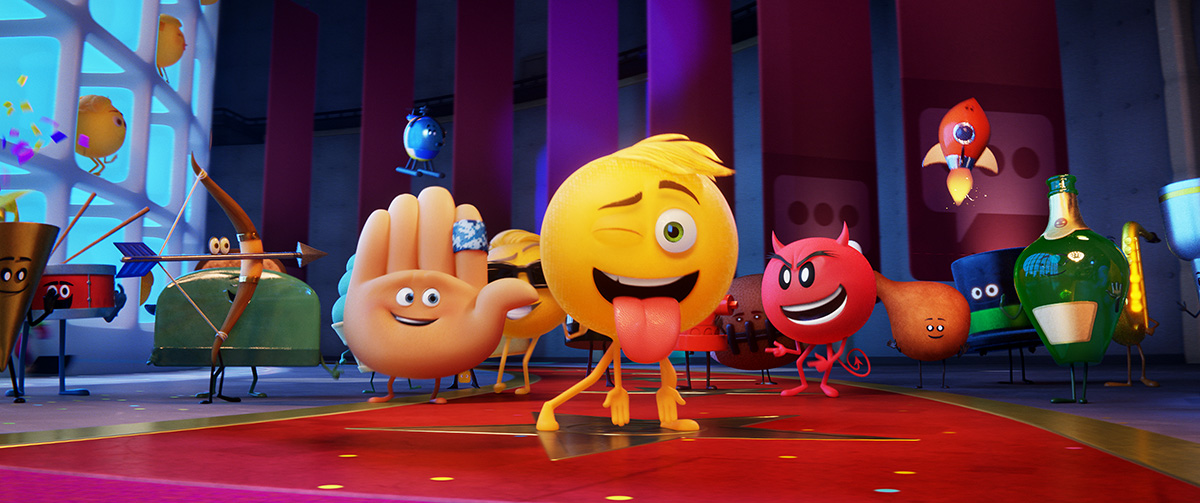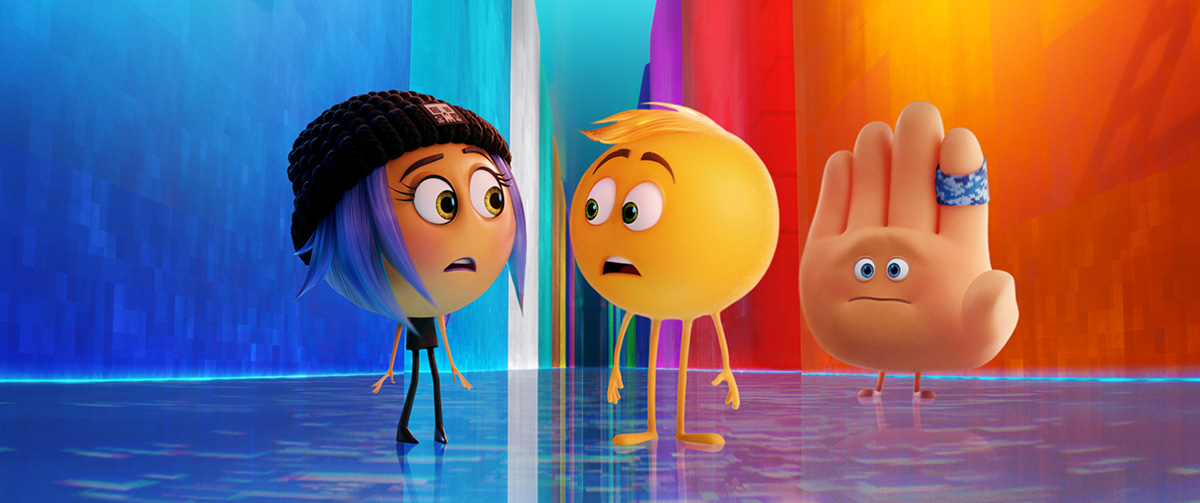INTERVIEW 2017
by Ian Failes, Spark CG Society
July 27, 2017
How Do You Animate an Emoji?

We’ve all probably sent emojis from our smart phones, in our emails, and in messaging apps. Now Sony Animation has taken us into the animated film world of the ubiquitous ideograms with Tony Leondis’ The Emoji Movie.
Behind the animation was Sony Pictures Imageworks out of its Vancouver and Los Angeles studios. We caught up with animation supervisor Sacha Kapijimpanga, who described the unique challenges of giving life to the many and varied emojis in the film.
These emojis at first appear to look quite simple in design, but as an animation supervisor, how do you jump on character designs and where did you look to add emotion and personality to these seemingly flat shapes?
Sacha Kapijimpanga: You’re right. These characters, out of any movie I’ve worked on, they’re super simple. They’re very basic in terms of design. How these characters are going to behave comes mostly from the performances of the actors and the casting. We had really good casting for this movie. Once we get the voices, we start doing kind of explorations in animations.
In terms of design, now, there isn’t a body, right? It’s basically a head with arms and legs. It’s really challenging to find poses that can convey what we’re trying to get across without all of these tools that we’re used to using, like the body posture. On these basic spheres we had the ability to slide the arms around, because he had a moving shoulder basically and moving hips that could connect anywhere in his body that helped us nail some poses down.
That was really challenging, but I think we overcame that and discovered ways to make them work really well. One of the really cool characters we had was Gene’s dad, Mel Meh, who was voiced by Steven Wright. He has a really super monotone type delivery. Once we got the voice for him, we started exploring ways he could move in a way that kind of worked with his voice.
We discovered that he has a really slow delivery, and really there’s not a lot going on in terms of inflexion and stuff like that. We tried different things like delaying his gestures to see if that would make something unique out of his character and try different things like dragging the gestures out, so he would be gesticulating with his arms. Even his gesticulations would go on for a little bit longer than you would typically animate, just to make him a little bit unusual.
The Gene character is a ‘meh’ which means he’s not supposed to react very much to anything, but Gene actually does — what range of emotions did you have to deal with?
Kapijimpanga: Well, Tony set up this rule where we could stay within a certain range. So, for Smiler, for example, we had to stay within 10% to 15% of a smiling expression no matter what her delivery was. That was a tough thing to do, because even when you start getting into some of the tighter ‘O’ shapes and some of the smaller mouth shapes that you have to make to even just deliver dialogue, you’re starting to get off model with her a little bit. With the mehs, it’s the same kind of thing. You try to stay within 10% to 15% of being meh at all times. That’s the only thing that makes these characters kind of unique, in a way.

From left, Jailbreak (voiced by Anna Faris), Gene (T.J. Miller) and Hi-5 (James Corden).
One character that really jumped out straight away was Hi-5, James Corden’s character. Here you had extra things you could animate, with the fingers, so how did you approach this character’s personality?
Kapijimpanga: He was one of my favourite characters actually in the movie. He was a big challenge at first, because Tony didn’t want to do too much squashing and stretching. He didn’t want to get too cartoony with our emotions in this movie. A lot of the storyboards for Hi-5 had him in kind of poses that felt like they were just a little bit more cartoony than the other characters. Like, he didn’t have arms, for example, so he used his pinky as an arm, and his thumb as an arm sometimes. Some of the poses we had to get into, we kind of just had to embrace the idea that we had to break his joints in his pinky to use that as an arm.
We had to embrace the idea that he was going to have to do that and not always look like a hand. Those challenges of turning that pinky into another arm kind of made him one of the most fun characters. Like some of the things the animators came up with were fantastic. I think he was a bit more pushed than some of the other characters, both because of James Corden’s performance, and just the design of the character forced us to be a little bit more cartoony with Hi-5. That was a lot of fun.
That’s interesting — you could go anywhere with having that much range of movement. Did you ever feel like you had to hold back?
Kapijimpanga: Initially, when we did some tests for the movie, we had all kinds of emojis that we were doing early tests with. We had a beer mug and some of the animation tests they did made it look more like there was liquid inside the mug as he was moving along. We also had some tests where we had an ice cream cone. We had a lot of squash and stretch in the ice cream as the ice cream was walking along. We were just doing some early kind of walk cycles to get things in front of Tony to see how he responded to things.
The rule he kind of established was that all of these characters, like the ice cream cone, for example, shouldn’t feel like ice cream in a cone. These were kind of plastic-y representations of characters. The beer mug, even thought it looks like a glass of beer, there’s no real beer inside. It’s an icon, so it’s not a liquid inside. We did all kinds of explorations for that stuff.
Can you talk about the face shapes and eyes and mouths? Did you investigate only having say a 2D face shapes approach at all?
Kapijimpanga: We did have fully 3D faces on the main characters, but we used 2D face shapes on some of the secondary and tertiary characters in the background. It was a design thing, because it was a simpler look for those characters, and sometimes they were further away, but also we were under serious time constraints on this movie as well. I think we have around 260 characters. Had we rigged all these characters with full 3D faces, it would’ve been impossible. We would never have gotten through the number of characters we had to.
They actually developed a system that used a 2D decal face rig, where we were basically animating almost 2D shapes on to the background characters. This worked really, really well. Then we would add a little bit more depth to them down the pipe. Then if a character ended up getting a slightly bigger part, then we can invest the time into making that a fully 3D character, but we tried to keep most of our development time and most of our rigging time into characters like Gene, who has full 3D faces, and a really, really broad range of movement.
This interview can’t finish without mentioning Poop, who’s voiced by Patrick Stewart. Did he have any unique challenges?
Kapijimpanga: All the animators who were interested in getting on the project were lured in by the idea of having Poop as a character you can animate. All of us has that in us, I guess — that inner child that just loves poop somehow. He’s a great character. Patrick Stewart’s voice was really fun to animate to. The idea was that he was a very proper kind of character who’s the butt of these jokes and he’s a little bit above all of that. He’s a really fun character to animate.
All images and clips, copyright 2017 Sony Pictures. All Rights Reserved.
 |
Ian Failes is a Sydney-based writer specializing in visual effects and animation. He also collects memorabilia from the film Speed. Follow him at @vfxblog. |
![]()
![]()
© 2025 · Spark CG Society

















